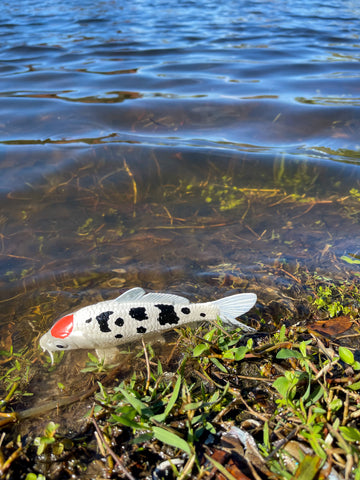on orders over $250
on orders over $250

Koi fish are large carp, known for their numerous color varieties. Koi have been bred since the 19th century in Japan, and t there are over 100 varieties that showcase a massive range of colors and patterns today.
Because of their vibrant and varied patterning, koi are kept in ponds for decorative purposes. One of the most common varieties is Kohaku, which means “red and white”. This type of koi is white with reddish-orange markings and was one of the first varieties developed in Japan. Taisho Sanshoku (often just called “Sanke”) koi are common like Kohaku but feature small black markings called Sumi. Lastly, Showa Sanshoku (often just called “Showa”) are black with red and white markings. 
PIETER IN JAPAN/FLICKR (CC BY-SA 2.0)
Other types of koi showcase many different patterns and styles, including Ogon koi (which are one solid color – either golden yellow, platinum white, or orange), Asagi koi (which feature light blue scales with red coloration on the underside), and Bekko koi (which are solid white, red or yellow koi with black Sumi dots).
These koi varieties are created through selective breeding, with desired traits being passed on from parents to their offspring. One type of koi that’s extra special because it cannot be selectively bred. This variety, the Tancho koi, has a single reddish-orange mark on its forehead.

The name “Tancho” comes from the Japanese name for the red-crowned crane. This large bird is all black and white with a single, striking red mark on its head. Since Tancho koi are similarly colored, they were named after this regal bird.
Tancho koi are rare because there is no way to breed them. Two Tancho koi may produce a Tancho offspring, but it is not guaranteed. The likelihood of Two Kohaku koi producing a Tancho Koi is the same as two Tancho koi parents. The placement of the red markings (known as “hi”) on the body is seemingly random, and it’s just the luck of the draw whether or not the red will show up as a symmetrical splotch on the forehead.

There are many varieties of Tancho Koi. Tancho Kohaku koi will be purely white, other than the reddish-orange mark on their head. This type is especially favored in Japan due to its resemblance to the Japanese flag - a white field with a red spot in the center to symbolize the rising sun. Tancho Sanke favor Tancho Kohaku, but with the addition of black Sumi markings on the upper portion of their body. Tancho Showa has a black body with white markings. Tancho Showa will sometimes have Sumi markings appear within their red spot, whereas Tancho Sanke will have a clear red spot unmarked by Sumi.
Tancho koi must be treated with care because too much stress or poor water conditions can cause their distinctive red markings to disappear completely!
Once the market is gone, the Tancho mark will never come back. Because of this, anyone with a rare Tancho koi should take extra steps to ensure that their special fish is not overly stressed, lest they wake up one morning to discover their fish has become much more ordinary.

If you want to guarantee yourself a Tancho koi, you can always get Safari Ltd®’s new Tancho koi figurine – you can count on every figure to have the distinctive marks of a Tancho Sanke koi, without all the hassle of trial-and-error breeding. Add this unique Incredible Creatures® koi fish figure to your collection today!